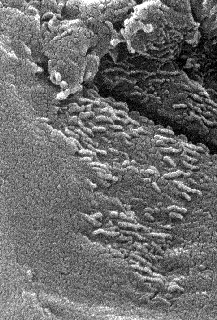An example of bacteria
Click on image for full size
JPL/NASA
Microbes Could Live on Mars!
News story originally written on September 4, 2002
Researchers have found tiny organisms that could survive the low atmospheric pressures of Mars. They are not actually Martians but are called methanogens and live here on Earth.
Because methanogens are very small, they are called microorganisms or microbes. They are members of a group of bacteria called Archaebacteria that are closely related to the first life on Earth and live in places where there is no oxygen like swamps, sewage and even in our guts.
To see whether these organisms would be able to survive in a Martian environment, researchers put the methanogen bacteria into a chamber where the pressure could be reduced to simulate the conditions on Mars. Despite the extreme environment, the little critters survived and grew!
Life like this may exist today below the surface of Mars where an underground ocean of ice sits. Or, creatures like these might have lived on Mars in the past!
Last modified September 4, 2002 by Lisa Gardiner.
You might also be interested in:

This page is the start of the tour which explores water on Mars. Use the navigation button at the top of the page to move through the tour. To go to the next page, just press the forward link on the navigation
...more
It was another exciting and frustrating year for the space science program. It seemed that every step forward led to one backwards. Either way, NASA led the way to a great century of discovery. Unfortunately,
...more
The Space Shuttle Discovery lifted off from Kennedy Space Center on October 29th at 2:19 p.m. EST. The weather was great as Discovery took 8 1/2 minutes to reach orbit. This was the United States' 123rd
...more
A moon was discovered orbiting the asteroid, Eugenia. This is only the second time in history that a satellite has been seen circling an asteroid. A special mirror allowed scientists to find the moon
...more
Will Russia ever put the service module for the International Space Station in space? NASA officials want an answer from the Russian government. The necessary service module is currently waiting to be
...more
A coronal mass ejection (CME) happened on the Sun early last month. The material that was thrown out from this explosion passed the ACE spacecraft. The SWICS instrument on ACE has produced a new and very
...more
J.S. Maini of the Canadian Forest Service called forests the "heart and lungs of the world." This is because forests filter air and water pollution, absorb carbon dioxide, release oxygen, and maintain
...more















